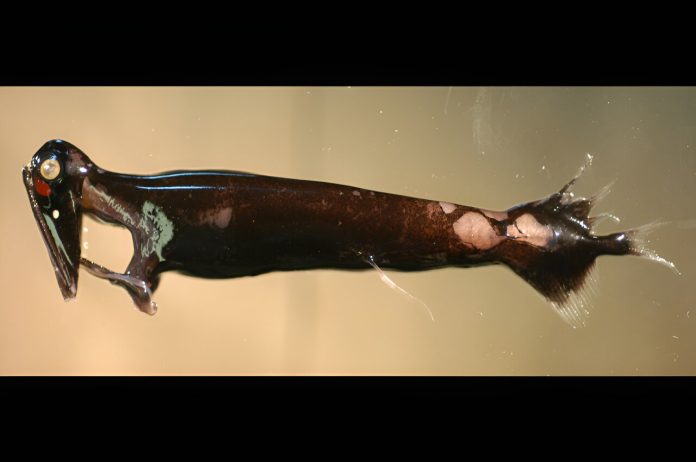
In the dark depths of the ocean, where light is scarce and life is a constant search for survival, the male dragonfish has evolved a unique adaptation to find a mate: larger eyes.
This discovery was made by researchers at Boston College, who found that male dragonfish develop bigger eyes to better locate females, who emit less light than males.
The findings were published in the journal Biology Letters.
Dragonfish are small but fierce predators living in the deep sea. These fish have various adaptations to survive in their dark environment, including bioluminescence—the ability to produce their own light.
However, as noted by Boston College biologist Christopher P. Kenaley, the lead author of the study, female dragonfish are not as bright as their male counterparts.
This difference led the researchers to investigate how male dragonfish manage to find their less luminous mates.
“We’ve found that these male dragonfish have evolved larger eyes to find females who produce less light,” said Kenaley. “It’s rather stunning and a really important insight into how these poorly known species exist and thrive in the deep sea.”
The study reveals a rare example of sexual dimorphism in the visual systems of vertebrates. Sexual dimorphism refers to differences in appearance between males and females of the same species.
In this case, it means that male dragonfish have larger eyes than females. Kenaley explained that such visual differences are extremely rare among vertebrates and have been observed in only a few fish species.
The deep sea, the largest biome on Earth, is a dark and barren place. The vast distances between individuals living in this environment make finding a mate particularly challenging. Most deep-sea animals produce bioluminescence to lure prey and attract mates. However, the males of many species have larger photophores (the organs that produce light) than females, which creates a unique problem: females can detect males at shorter distances than males can detect females.
“This creates a paradox: if bioluminescence is important in sexual signaling and finding each other, this dimorphism results in a scenario in which females can detect males at shorter distances than the reverse,” Kenaley said.
“In short, there’s a bioluminescent detection gap. We hypothesized that, to close this gap, males might have evolved larger eyes to capture more light.”
Kenaley and his team, including Boston College undergraduates and Stockholm University biologist Valentina Di Santo, studied two species of deep-sea dragonfish: Malacosteus niger and Photostomias guernei.
These species exhibit sexual dimorphism in the size of their photophores. The team modeled the distances at which males and females of each species could see each other based on eye size and the amount of light produced by the opposite sex.
Their research revealed a significant detection gap in both species, ranging from a few meters to over 100 meters. They also discovered that males of both species have larger eyes, which help reduce this gap by about 5 meters. While this might seem like a small improvement, it is significant in the challenging task of finding a rare mate in the vast open ocean.
Previous research had suggested the existence of a bioluminescent detection gap, but the Boston College-led team is the first to quantify this gap and show that male dragonfish have evolved larger eyes to overcome it.
Kenaley said future studies might focus on why males are brighter than female dragonfish. “We don’t yet know exactly why luminescent dimorphism exists in these and other deep-sea species,” he said.
“Perhaps it’s a way of signaling to one another that a member of the opposite sex is nearby.
Answering this question will require more studies like ours that establish a pattern of how detection distances vary with levels of dimorphism.”
This discovery highlights the remarkable adaptations of deep-sea creatures and provides new insights into the complex behaviors that enable them to survive and reproduce in one of the most extreme environments on Earth.



